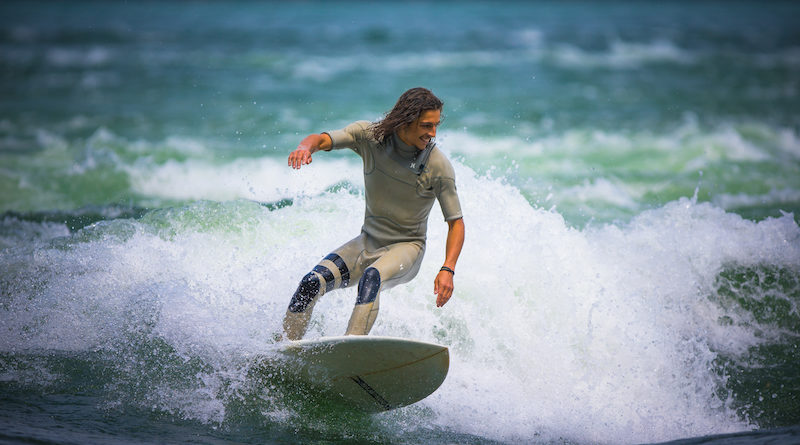Surfing the Endless Wave
The Montreal surf scene is heating up with a new record for riding a wave, a surf school in full swing and a scene like you might find at a California break.
At dawn on June 8, Guillaume Larouche headed out his front door, down the streets of Chambly, just south of Montreal, and dove into the Richelieu river, which runs from Lake Champlain to the St. Lawrence. Larouche, a legend in the local kayak and paddling world, paddled his Taiga surf SUP out to his favorite wave, a curling four-foot swell that the river kicks up as it passes over submerged rocks.
“I was in the water at 6:45 a.m.,” says Larouche, a 44-year-old school teacher. “And for the next six hours, I was surfing steadily.” Not, surfing one wave and then paddling out for another, but steadily surfing one wave.
For exactly 6 hours and 12 minutes, Larouche stayed on that wave, carving his board in and out, paddling occasionally so as not to lose the push of the river. “The hardest thing was the water was so cold my feet kept freezing so I had to hop around on the board,” he said.
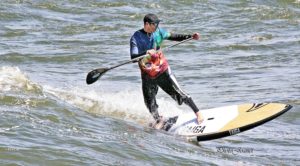
At times, as the sun rose on the horizon, the glare off the wave’s surface disoriented him. “I thought about jumping off after four hours but then decided no, I’ll keep going. I could have kept on far longer than six hours but it was exhausting,” he admits.
Larouche, a dedicated paddler, had trained for the event by doing 5,000 squats over a month and he hopes his time will make the Guinness Book of World Records for the longest single-wave surf session ever. “I teach at an alternative school and my class focuses on students following their passions,” he said in a phone interview. “This was about me persevering. I want to be a model for them.”
He Came for the Waves
Larouche is one of a growing cadre of kayakers, SUP’ers and surfers who are flocking to inland whitewater. While most wave chasers head to the coasts of Maine and New Hampshire or to the Cape and islands, some top paddlers are finding the lack of crowds and the consistent waves that kick up on the St. Lawrence and other rivers around Quebec appealing.
“I moved to Montreal for the waves,” says Corran Addison, a 50-year-old Olympic kayaker from South Africa, who first saw the St. Lawrence waves during a competition more than 20 years ago. “Guys were telling me there were these giant waves out in the middle of the river, like overhead,” he says. He found them and kayaked them, impressed by their power and regularity.
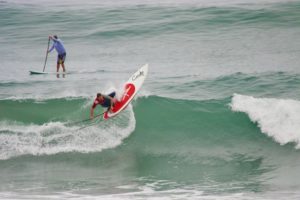
“Then in 2002, I had just come back from Hawaii. It was early spring and I looked out and thought: I wonder if I could surf these on a surfboard? I grabbed my 7-foot, 6-inch egg-shaped surfboard and headed out.”
At first, Addison was, by his reckoning, the only one to surf the St. Lawrence. He started a surf school, Imagine, and recruited and taught friends, including Guillaume Larouche and his brother, Yannick and former Olympic kayaker Hugo Lavictoire, owner of the school Kayaking Sans Frontiers. “It was safer to have more of us out there. It can be very dangerous with submerged rocks and other hazards and the river flowing at 300,000 cubic feet per second in spots,” says Addison.
Addison pioneered several surf spots such as Habitat 67, a zone named for the boxy, architecturally avant-garde apartment complex that sits above it, and some of the hairier waves (many of which require tow-ins) that rise head high off Lachine, such as “Mavericks.”
Addison began teaching at Habitat 67 and Lavictoire offered surf lessons from his kayak school in LaSalle. The LaSalle break called Vague à Guy has since become the preferred learning spot. Addison grew his school and board shaping shop to the point where it was bought by a California company. He moved with it.
But in 2015, he returned. “I came back for the waves. Out there [in California] it’s good—and sometimes great. But here, it’s always good. Sure, there are more crowds. There’s a bit more attitude now too. But in the time since I left, a real surf scene has built up here,” says Addison. “You go to Vague à Guy and you see 50 to 100 people milling around in board shorts, stickers on their cars, talking the lingo, looking the part.”
He says it’s still not hard to catch a wave there. “You have to paddle into the right spot but then you can surf for 10 or 15 seconds, then drop off and let someone else have a turn.”
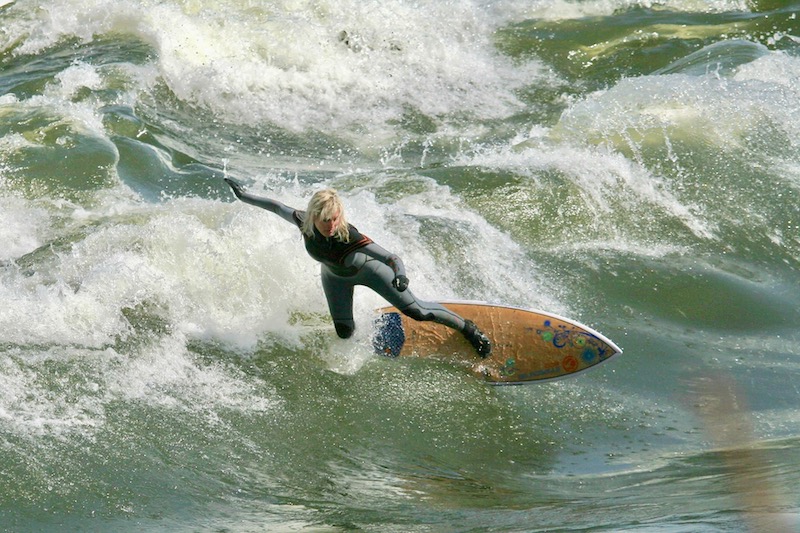
Addison no longer gives lessons but now runs Soul Waterman, which makes whitewater paddleboards, river surfboards and kayaks. “If you’re planning to try surfing here I recommend something wide, short and flat—something 20 inches wide, 2 ½ inches thick and not too small—maybe six feet. And be ready to hit a rock.
What Addison will also tell you is don’t try to figure out the river on your own. “It’s a really strong current and you have to know what you’re doing, so it’s a must to take a lesson or go with someone who really knows the river, even if you are experienced,” he says.
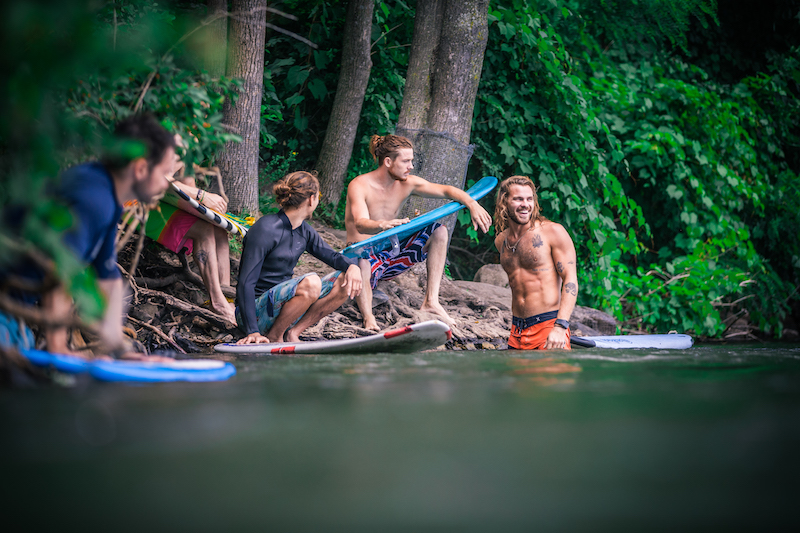
Hugo Lavictoire’s company KSF teaches surf kayaking, SUP surfing and standard stand-up surfing, with a three-hour lesson at Vague à Guy (equipment included) going for $80 CDN. After mastering that, students can progress up to the more difficult waves at Habitat 67.
While there are other spots along the river that may be accessible, currents and undertows can be very strong and both Lavictoire and Addison caution against exploring. “If no one is surfing there, it’s for a reason,” says Addison.
The Vermont Surf Scene
Around the country, inland towns such as Glenwood Springs, Colo., Bend, Ore., and Boise, Idaho have built features into rivers to create waves and downtown whitewater parks. Like skateparks or playgrounds, they have become popular with both those who are catching the waves and those who stand ashore watching. “River surfing has definitely become a thing,” says Addison.
Vermont has several rivers that kick up waves after a big rain or snowmelt, that are occasionally, big enough to surf. Brian Mohr, the Moretown-based photographer who spends part of his year surfing in Costa Rica and in Nantucket, has used an old beater surfboard and caught rides on waves in the Mad River. And pro surfer Ben Gravy included a session on the Mad River as part of his campaign to surf in every state.
However, the biggest and best chance of catching a wave from a Vermont shoreline remains waiting for a strong, windy day on Lake Champlain.

Tamas “Tommy” Buday, Jr. is another former Olympian (his father coached the Canadian team and he competed in three Olympics in sprint canoe) who is part of the SUP scene around Montreal. “I don’t do that much surfing,” says Buday, who also comes down to Burlington once a week to coach SUP paddle technique at the Burlington Surf Club. However he and a few others do take advantage of the rollers that build up on Lake Champlain to do long downwind paddles, with some surfing down the waves.
“If you discount the surf, I actually think there’s no better SUPing than on Lake Champlain,” says Buday.
Featured Photo Caption: Frederick Asselin in his element at Habitat 67. Photo by Mike Hitelman

